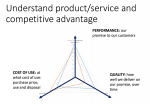The company is its products
Don’t kid yourself, your engineering strategy is your strategy.
Engineering has progressively been devolved by professional managers to just another department who’s job is to realize the long list of specifications Marketing has dreamed up – as well as take into account whatever senior executive preference tickles them at the time.
All customers see is the product or service. What the engineering department designs and how easy it is to build or deliver is what customers purchase, use, live with and pay for. This is what customers choose – or not. Nothing else.
In a competitive, saturated market, growth comes from selling one extra product, which means that a competitor doesn’t make that sale. If you want to double your sales, imagine how many competitors don’t make that sale.
So your product’d better be better at:
- How it looks at first glance? How cool and attractive is it?
- How well it does the job? What is the trade-off of services (mmm!) versus sacrifices (aarh!) it imposes on you?
- How attached one gets to it?
- Does it feel like a good deal or do you soon think you’ve been had?
Which means fundamentally understanding the essence of competitive advantage:

- Performance: what is our promise to customers?
- Quality: how well do we hold to that promise? Where do we let them down?
- Total cost of use? Beyond purchasing price, what other costs or hassles do customers need to pay out when they use our stuff?
- Profitability: Can we live on what’s left?
And where do competing products fit on these scales?
These maybe be Value Analysis questions (improving product delivery in production) or Value Engineering questions (improving the value proposition in the design) but in any case they will involve engineering, and engineering’s ability to work concurrently with sales, production and the supply chain.
You can have any strategy you like, but in the end, your engineering strategy is the only one that counts.









